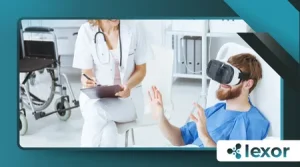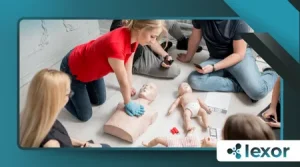How VR Is Helping First Responders and Emergency Trainings

VR is helping first responders save lives in ways previously unimaginable. From high-risk fire simulations to trauma surgery drills, virtual reality is transforming emergency preparedness.
The stakes in emergency response are unforgiving—every second counts, and mistakes cost lives. Traditional training methods, though valuable, often lack realism and scalability.
Enter VR: an immersive, adaptable, and risk-free solution reshaping how first responders train.
But why is this shift happening now? The answer lies in the rapid advancements in VR hardware, AI-driven simulations, and a growing demand for cost-effective, repeatable training.
Unlike conventional drills, VR allows responders to fail safely, learn from mistakes, and refine their instincts in hyper-realistic scenarios.
The implications are profound. Firefighters, paramedics, and disaster response teams can now rehearse rare but catastrophic events—chemical spills, mass shootings, building collapses—without real-world risks.
VR is helping first responders not just train better but also recover faster from psychological stress.
The Critical Need for Advanced Training in Emergency Response
Emergency personnel face unpredictable scenarios daily.
A firefighter battling a chemical blaze, a paramedic stabilizing a multi-trauma victim, or a SWAT team navigating an active shooter situation—each demands split-second precision.
Yet, traditional training has limitations. Live drills require extensive resources: staged environments, actors, medical dummies, and safety personnel.
These exercises are expensive, difficult to replicate, and often lack the unpredictability of real emergencies.
This is where VR steps in. By simulating high-pressure situations with dynamic variables, responders gain experience without real-world consequences.
A 2024 report by the National Fire Protection Association (NFPA) found that departments using VR saw a 28% improvement in operational readiness compared to those relying solely on conventional methods.
Moreover, VR enables training for low-frequency, high-risk events—like nuclear plant disasters or bioterrorism attacks—that are nearly impossible to recreate physically.
++How to Extend the Life of Your Electronic Devices
The ability to practice these scenarios repeatedly ensures that when disaster strikes, muscle memory and decision-making are already sharpened.
Immersive Simulations: VR is helping first responders
Imagine a paramedic performing an emergency tracheotomy on a virtual patient whose vitals react in real time. Or a firefighter navigating a collapsing building with heat sensors mimicking actual flames.
These aren’t sci-fi fantasies. Companies like Osso VR and Flaim Systems are already deploying hyper-realistic VR training modules.
A study by the National Institute of Standards and Technology (NIST) found that VR-trained firefighters showed 40% faster decision-making in live exercises compared to traditional methods.
But realism is just one advantage. VR also offers scalability—a single headset can simulate countless emergencies, from car crashes to wildfires.
++Virtual Reality in Automotive Design and Engineering
Training centers no longer need massive physical setups; instead, they can run multiple drills simultaneously in virtual space.
The psychological impact is equally significant. Unlike static mannequins, VR patients exhibit dynamic symptoms—gasping for air, bleeding out, or going into cardiac arrest.
This forces trainees to adapt on the fly, improving diagnostic speed and accuracy.
| Training Method | Retention Rate | Cost Efficiency |
|---|---|---|
| Traditional Drills | 60% after 6 months | High (equipment, logistics) |
| VR Simulations | 85% after 6 months | Scalable, reusable |
Real-World Breakthroughs in VR Emergency Training

1. Virtual Trauma Training for Paramedics
The University of Maryland’s Shock Trauma Center uses VR to simulate mass casualty incidents. Trainees triage virtual patients under time constraints, improving accuracy under pressure.
One notable case involved a simulated multi-vehicle collision where EMTs had to prioritize victims based on injury severity. Those trained in VR made 23% fewer triage errors than their peers in live drills.
2. Firefighter Stress Inoculation
The FDNY employs VR to recreate high-stress fire scenarios, helping recruits build mental resilience before facing real flames.
++Best VR Headsets in 2025: Which One Should You Buy?
Trainees wear haptic suits that mimic heat and debris impact, enhancing realism.
A 2025 FDNY internal review found that VR-trained recruits had 35% lower panic responses in their first real fires compared to those trained traditionally.
Why VR Outperforms Conventional Training Methods (VR is helping first responders)
Unlike static mannequins or scripted drills, VR adapts to user actions. A trainee’s mistake triggers realistic consequences—without real-world harm. This dynamic feedback loop accelerates learning.
Think of VR training like a flight simulator. Pilots practice catastrophic failures in a safe space. Similarly, VR is helping first responders rehearse worst-case scenarios before encountering them.
Another advantage is debriefing. After a VR session, trainers can replay the simulation, pinpointing errors and discussing improvements. This level of post-training analysis is nearly impossible with live exercises.
The Psychological Edge: Stress Training Without Risk
First responders often suffer from PTSD due to high-stress exposure. VR allows controlled exposure therapy, helping them build emotional resilience.
A 2024 study in JAMA Network Open found that VR-based stress training reduced anxiety levels in EMTs by 32% compared to traditional methods.
The technology also aids in mental health recovery. Departments like LAPD use VR to simulate traumatic calls in a therapeutic setting, helping officers process incidents without retraumatization.
Challenges and the Road Ahead for VR in Emergency Training
Adoption barriers remain—cost, hardware limitations, and skepticism from traditionalists. But as technology advances, these hurdles shrink.
Will VR replace live drills entirely? Unlikely. But it’s becoming an indispensable tool. VR is helping first responders refine skills, reduce training costs, and, ultimately, save more lives.
The Future: VR is helping first responders
Emerging AI integrations allow VR scenarios to evolve in real time, offering endless variations. Soon, a paramedic might train alongside an AI-generated team, refining teamwork without human counterparts.
For now, one truth is undeniable: VR is helping first responders in ways we’re only beginning to explore.
Further Reading:
Final Thought: A Lifesaving Paradigm Shift
The marriage of VR and emergency training isn’t just innovative—it’s necessary. As disasters grow more complex, so must our preparedness.
Are we ready to embrace this digital revolution? The answer could mean the difference between life and death.
Frequently Asked Questions
Q: How does VR improve decision-making for first responders?
A: VR provides realistic, high-pressure scenarios that enhance situational awareness and reaction times. Studies show VR-trained responders make faster, more accurate decisions.
Q: Is VR training replacing traditional methods entirely?
A: No. VR complements live drills by offering risk-free, repeatable practice for rare or dangerous situations.
Q: What are the costs of implementing VR training?
A: Initial setup can be expensive, but long-term savings (reduced equipment, logistics, and reusable simulations) make it cost-effective.
